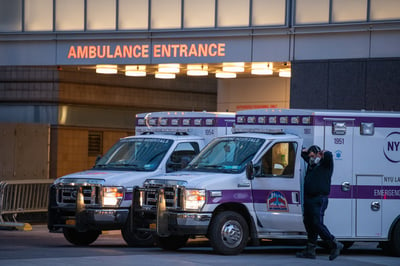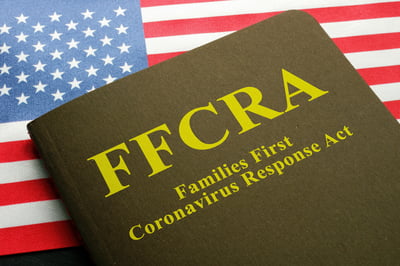4 Must-have Data Points for Dispatch-Billing Alignment and Maximum Reimbursement
4 Questions About How the COVID-19 Medical Leave Impacts EMS Agencies
(6 min read) Without a doubt, COVID-19 has presented EMS agencies with multiple challenges that collectively are some of the most significant they have ever faced
Was this information valuable?

(6 min read) Without a doubt, COVID-19 has presented EMS agencies with multiple challenges that collectively are some of the most significant they have ever faced. Revenue has dropped dramatically for many agencies, as people have been reluctant to seek needed medical care for fear of contracting COVID-19. There have been personal protective equipment (PPE) supply shortages. All EMS agencies have struggled with being on the front lines of the pandemic with the myriad of challenges that presents. One of the biggest challenges COVID-19 presents is the need to always be ready to respond and to have a sufficient number of healthy EMS personnel available.

How Does the Families First Coronavirus Response Act (FFCRA) Apply to EMS?
The Families First Coronavirus Response Act (FFCRA) was passed to protect employees’ need for leave during the COVID-19 pandemic. The FFCRA applies to certain public employers and to private employers with fewer than 500 employees. The Emergency Family and Medical Leave Expansion Act (EFLEA) and the Emergency Family Paid Sick Leave Act (EPSLA) authorize the Department of Labor to issue regulations (which it has done) to exempt healthcare providers and emergency responders from eligibility coverage under the FFCRA. Section 826.30(c) of the Department’s Regulations implementing EFLEA and EPSLA (which, for simplicity’s sake, from this point forward are also collectively referred to as “FFCRA”), 29 C.F.R. Section 826(c), says that healthcare providers and emergency responders may be excluded by the employer from the paid sick leave provisions and/or expanded family and medical leave provisions under the FFCRA.
Who Is an Emergency Responder Under the FFCRA?
According to Frequently Asked Question #57 on the Department of Labor’s website:
[A]n emergency responder is anyone necessary for the provision of transport, care, healthcare, comfort and nutrition of such patients, or others needed for the response to COVID-19. This includes but is not limited to . . . military or national guard, law enforcement officers, . . fire fighters, emergency medical services personnel, physicians, nurses, public health personnel, emergency medical technicians, paramedics, emergency management personnel, 911 operators, . . . and persons with skills or training in operating specialized equipment or other skills needed to provide aid in a declared emergency, as well as individuals who work for such facilities employing these individuals and whose work is necessary to maintain the operation of the facility. This also includes any individual whom the highest official of a State or territory, including the District of Columbia, determines is an emergency responder necessary for that State’s or territory’s or the District of Columbia’s response to COVID-19.
This means that all EMS providers, dispatchers, and operational personnel who oversee EMS providers can be excluded from the leave provisions covered by FFCRA.
What Other Protections Are Available for EMS Employees?
Just because an employer of EMS personnel is not required to offer EMS personnel leave under the FFCRA, that does not mean that the employer must exclude these personnel. It is unlikely that an EMS agency would want an employee infected with COVID-19 to come to work and spread the virus to employees and patients. An agency might, however, choose to offer its employees who contract the coronavirus paid sick leave, while choosing not to extend leave to employees caring for a sick family member. The bottom line remains that EMS employers are not required to offer paid FFCRA leave to employees affected by COVID-19.
Additionally, if an EMS employer chooses to exclude its personnel from paid leave under the FFCRA, the employee must be permitted to use any accrued paid time off and/or sick leave for one of the reasons that would be covered under the FFCRA.
Conversely, if an EMS employer chooses not to exclude its EMS personnel from the paid sick leave provisions of the FFCRA, it must permit the employee to use FFCRA paid sick leave before using any other type of paid leave to which the employee would otherwise be entitled (such as sick leave and/or paid time off).

There are other federal, state, and local leave laws that are not affected by the FFCRA and that are still available to EMS employees of covered employers who may need to take leave because they or a family member has contracted COVID-19. Federally, these include the Family and Medical Leave Act (FMLA) and the Americans with Disabilities Act (ADA). If an employer is subject to the FMLA and the employee has a serious health condition, then the employee may still be entitled to up to twelve weeks of FMLA leave. Also, don’t forget about Workers' Compensation. If an EMS employee contracts COVID-19 and has recently been exposed to a patient or co-worker who has COVID-19, then the employee may have a Workers' Compensation claim related to the illness.
Are All EMS Employees Excluded from the FFCRA?
All EMS employees are not necessarily exempt from the FFCRA. For example, if an EMS agency does its billing in-house, its billing staff likely are covered and are not part of the exemption for healthcare providers. Therefore, it is important for EMS employers to be knowledgeable on FFCRA requirements, which apply through December 31, 2020. These include:
-
Two weeks (up to 80 hours) of paid sick leave at the employee’s regular rate of pay where the employee is unable to work because the employee is quarantined (pursuant to a federal, state, or local government order or advice of a healthcare provider), and/or is experiencing COVID-19 symptoms;
-
Two weeks (up to 80 hours) of paid sick leave at two-thirds the employee’s regular rate of pay because the employee is unable to work because of a bona fide need to care for an individual subject to quarantine (pursuant to a federal, state, or local government order or advice of a healthcare provider), or to care for a child (under 18 years of age) whose school or child care provider is closed or unavailable for reasons related to COVID-19, and/or the employee is experiencing a substantially similar condition as specified by the Secretary of Health and Human Services, in conjunction with the Secretaries of the Treasury and Labor; and
-
Up to an additional 10 weeks of paid expanded family and medical leave at two-thirds the employee’s regular rate of pay where an employee, who has been employed for at least 30 calendar days, is unable to work due to a bona fide need for leave to care for a child whose school or child care provider is closed or unavailable for reasons related to COVID-19.
Commonsense Best Practices for EMS Agencies
All EMS employers should make sure that they are checking employees for symptoms of COVID-19, ensuring that any who are experiencing COVID-19 symptoms do not come to work. At a minimum, EMS employers are advised to offer time off to their employees until the they have fully recovered.
For information on COVID-19 and EMS medical leave, please visit PWW's EMS Law COVID-19 Corona Update Webpage.
Read more about COVID-19 Legislation and EMS:
How EMS Providers Can Spend CARES Act Relief Funds and Prepare for an Audit
Related Posts
How EMS Agencies Can Reframe Need and Refocus Resources With Geospatial Analytics
How To Minimize Radio Chatter and Reduce Guesswork With Smarter Dispatch Resource Management
ZOLL Pulse Blog
Subscribe to our blog and receive quality content that makes your job as an EMS & fire, hospital, or AR professional easier.
ZOLL Pulse Blog
Subscribe to our blog and receive quality content that makes your job as an EMS, fire, hospital, or AR professional easier.




